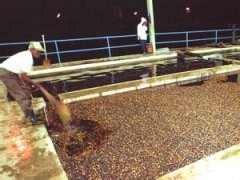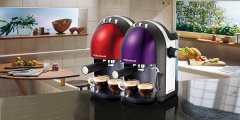[Coffee Roasting] Fire damper control of roasting machine (I)| Coffee Workshop

For professional baristas, please follow the coffee workshop (Wechat official account cafe_style)
In the process of roasting coffee beans with most drum roasters, after the raw beans are dropped into the roaster according to the established initial parameters, the whole baking process can only be controlled by adjusting the firepower and the size of the throttle at a specific time.
So, how to distribute firepower and throttle, choose when to adjust, and even how to control the throttle to reasonably preheat the roaster between each batch of beans before baking, so as to improve the consistency of each batch of beans under the same amount of beans and the amount of beans, all these will affect the final taste of coffee.
In the process of roasting coffee, the general heat is transferred to the coffee bean through three aspects, including the heat conduction between the roaster boiler and the coffee bean, the thermal convection and infrared heat transfer between the hot air and the coffee bean in the roaster. But the proportion of infrared heat transfer is very small. Therefore, it mainly depends on the heat transfer directly through the heat conduction of the boiler wall and the thermal convection of hot air, but there will be a dominant between the two, which mainly depends on the design of the roaster.
The roaster generally uses burning gas or electric heating device as the heat source, and adjusting firepower is to control the amount of heat provided by the heat source per unit time to the roaster. The heat source of the roaster not only heats the boiler, but also heats the air pumped into the boiler by the exhaust fan around the heat source, resulting in thermal convection. In addition, the roaster boiler is a relatively airtight space, so the heating of the air in the boiler will lead to a rise in pressure and a pressure difference with the environment outside the boiler. The pressure in the boiler also has a great influence on the baking, and controlling the firepower can affect the temperature rising speed of the environment in the roaster per minute, which also affects the pressure in the roaster.
The throttle is generally achieved by adjusting the opening of a baffle at a certain position of the smoke pipe installed in front of the exhaust fan of the roaster, or some roasters are achieved by adjusting the speed of the exhaust fan. The use of the throttle is to control the air flow and velocity in the boiler. The size of the throttle will affect the effect of hot air in the boiler on the heating of coffee beans. Under the premise of sufficient heat, slightly increasing the throttle can enhance the effect of hot air on coffee beans, but if the heat is not enough or the throttle is too large, the boiler will lose temperature. Opening the throttle when necessary can more quickly remove the silver skins and particles that make the coffee smell. The size of the throttle will also affect the pressure of the boiler and the development of coffee beans.
So specific to the actual example, how to bake a satisfactory pot of coffee beans by properly adjusting the firepower and throttle at all stages of coffee roasting? The following chapters will slowly share their own experiences!
To be continued.
Important Notice :
前街咖啡 FrontStreet Coffee has moved to new addredd:
FrontStreet Coffee Address: 315,Donghua East Road,GuangZhou
Tel:020 38364473
- Prev

It turns out that coffee is also a good proprietary Chinese medicine.
Communication of professional baristas Please pay attention to Coffee Workshop (Wechat official account cafe_style) as a kind of exotic tropical plant, coffee was introduced very late in our country, and there are few records in traditional Chinese medicine books. However, in recent years, coffee, one of the three largest drinks in the world, has gradually become popular among Chinese people and become an important daily drink with hot taste. Today, let's talk about coffee from the perspective of traditional Chinese medicine.
- Next

[tasting] developed senses are the best respect for coffee (1) | Coffee workshop
The exchange of professional baristas Please pay attention to the Coffee Workshop (Wechat official account cafe_style) the developed senses are the best respect for coffee a few days ago I met a lovely girl who is very interested in but knows nothing about individual coffee, because the girl is so cute and likable, I decided to take her into the vast prairie of boutique coffee. The shop basically meets every morning.
Related
- Beginners will see the "Coffee pull flower" guide!
- What is the difference between ice blog purified milk and ordinary milk coffee?
- Why is the Philippines the largest producer of crops in Liberia?
- For coffee extraction, should the fine powder be retained?
- How does extracted espresso fill pressed powder? How much strength does it take to press the powder?
- How to make jasmine cold extract coffee? Is the jasmine + latte good?
- Will this little toy really make the coffee taste better? How does Lily Drip affect coffee extraction?
- Will the action of slapping the filter cup also affect coffee extraction?
- What's the difference between powder-to-water ratio and powder-to-liquid ratio?
- What is the Ethiopian local species? What does it have to do with Heirloom native species?

